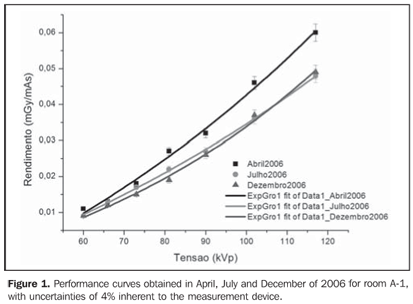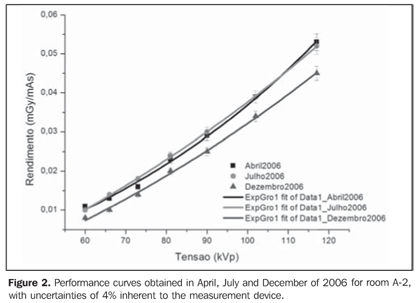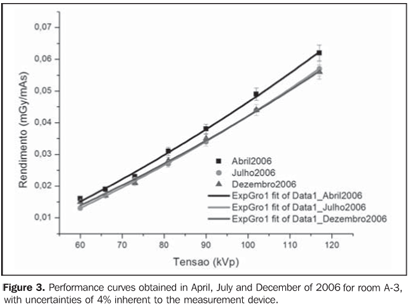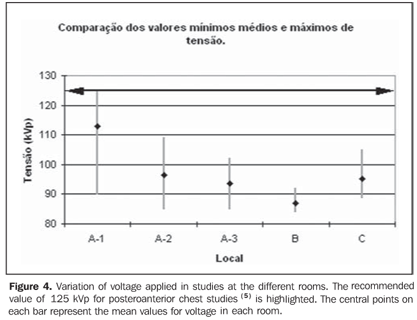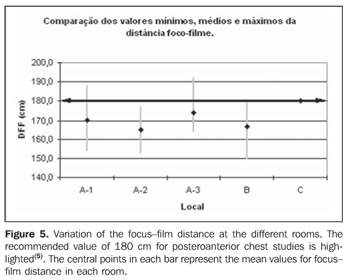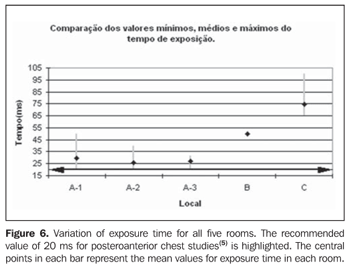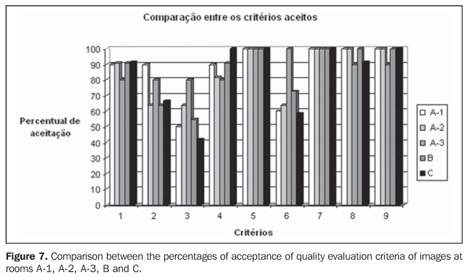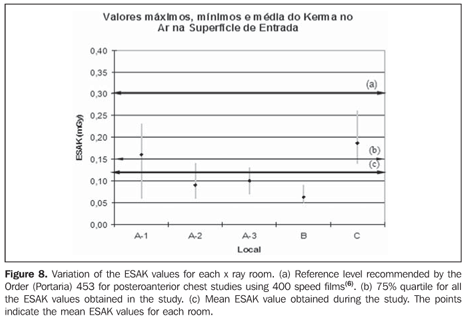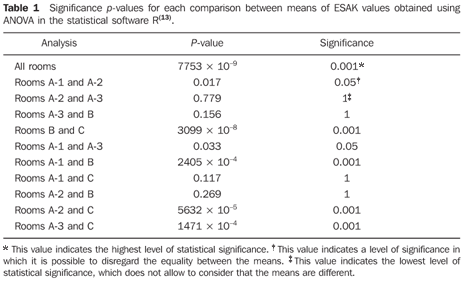Radiologia Brasileira - Publicação Científica Oficial do Colégio Brasileiro de Radiologia
AMB - Associação Médica Brasileira CNA - Comissão Nacional de Acreditação
 Vol. 42 nº 5 - Sep. / Oct. of 2009
Vol. 42 nº 5 - Sep. / Oct. of 2009
|
ORIGINAL ARTICLE
|
|
Evaluation of entrance surface air kerma rate and clinical images quality in chest radiography |
|
|
Autho(rs): Angelo Bernardo Brasil de Souza, Simone Kodlulovich Dias, Fernando Mecca Augusto, Winston Andrade Marques |
|
|
Keywords: Reference levels, Optimization, Quality, Radiographic techniques |
|
|
Abstract:
IFellow Master degree (Scholarship), Program of Biomedical Engineering – Instituto Alberto Luiz Coimbra de Pós-Graduação e Pesquisa em Engenharia/Universidade Federal do Rio de Janeiro (COPPE/UFRJ), Rio de Janeiro, RJ, Brazil
INTRODUCTION The dose absorbed by the patient submitted to a conventional radiology procedure is low when compared with other medical practices using ionizing radiation. However it is a known fact that among all other artificial sources, it is the one with the largest contribution to collective dose(1). Many radiological studies are performed without a previous assessment of alternative diagnosis techniques. Over the past few years, several studies have indicated dose differences above two orders of magnitude for the same type of radiological study, demonstrating that the dose s received by the patients during medical procedures can be significantly reduced without compromising the diagnosis(2,3). These results evidence the need to reevaluate the procedures in order to reduce the dose without compromising image quality. Such objective may be reached using as a reference the minimum radiation dose required for obtaining acceptable quality images. Such values were initially defined in the nineties by the International Atomic Energy Agency (IAEA) with the support of the European Community (EC) and were denominated levels of reference(4,5). In Brazil, the Ministry of Health established in the Order (Portaria) 453(6), the reference levels based on values published in the Basic Safety Standards (BSS)(7). The research in radiodiagnosis in the country is developed by researchers working isolatedly, applying different methods(8–11). In order to determine local reference levels, a coordinated and standardized large-scale study must be undertaken in Brazil. The objective of the present study is to evaluate the techniques employed in posteroanterior chest radiography, the entrance surface air kerma (ESAK) received by each patient as well as the resulting images quality, based on quality criteria established by EC(5), in a sample of ten standard patients, as recommended by IAEA(4).
MATERIALS AND METHODS The research was divided into the following phases: obtaining the performance curves of the x-ray equipment; recording the technical factors (voltage, focus–film distance and current × time product); evaluation of images quality; ESAK calculation and results analysis. The study was developed in three hospitals in the city of Rio de Janeiro, as follows: Hospital A, with three x-ray rooms, all of them with a Heliophos unit (Siemens; São Paulo, Brazil), and hospitals B and C, with one room each, using a Compacto 500unit (VMI; Minas Gerais, Brazil) and a RT 500/125 unit (Ray Tec; São Paulo, Brazil), respectively. All of the x-ray units had a 2.5 mmAl filter and all the studies were performed with grids. For each one of the rooms, ten standard patients (1.60 to 1.80 m in height and weighting 60 to 80 kg) were selected, in compliance with the IAEA TECDOC 1423(4) recommendations. The three hospitals have a quality assurance program maintained by their respective medical physicists, including periodic quality control testing of their processors. The performance curve was obtained using a dosimetric set manufactured by Radcal (Radcal Corp.; Monrovia, USA) comprising a 10X5-6 ionization chamber connected with 9060 current-frequency converter and with a 9015 measurement unit. The ionization chamber was positioned over a base of non-scattering material at the center of the radiation field and at a distance of 100 cm from the x-ray focal point. The collimator was opened until the radiation field entirely covered the sensitive volume of the ionization chamber, with a maximum excess of 5 cm. The ionization chamber was kept at a distance of approximately 15 cm from the table, in order to minimize the effect of scattered radiation. Keeping the current × time product fixed at 32 mAs, three readings for each voltage level between 60 and 117 kVp were performed. The performance was determined by the ratio between the mean of the air kerma readings for each voltage level and the current × time product utilized. The uncertainty level of the equipment used in the measurements is 4% of the reading values. The performance curve as a function of applied voltage was adjusted by the exponential function shown on equation (1).
where: y is the performance for a voltage x e A; t and y0 are the coefficients of the exponential curve, whose values vary for each equipment. In the hospitals, forms were utilized for the acquisition of the following data: date and room where the studies were performed; identification of the patient for ensuing access to the images; weight and height in order to verify whether or not the patient could be considered a standard patient(4); voltage applied in the tube; current × time product; patient–focus distance; focus–film distance and type of projection. Each patient was informed about the purpose of the study before submitting personal data. Height and weight were checked before the performance of the studies. The technical factors were compared with the following values recommended by EC(5): voltage of 125 kVp; focus–film distance of 180 cm, considering an interval of 140 to 200 cm as acceptable, and maximum exposure time of 20 ms. At hospital A, the images are kept on file and were evaluated after the end of the technical data acquisition and patient data acquisition. At hospitals B and C, the evaluation of image quality was performed immediately after the study, as the images were given to the patients after the medical reports were issued. The criteria for assessment of image quality presented below were based on those published by EC(5): 1) full inspiration; 2) thoracic symmetry; 3) medial border and scapula out of the pulmonary field; 4) accurate visualization of the vascular pattern of the entire lung; 5) accurate visualization of the trachea; 6) accurate visualization of the main bronchi; 7) accurate visualization of cardiac and aortic margins; 8) accurate visualization of the costophrenic angles; 9) accurate visualization of the diaphragm. Images complying with at least 65% of the above criteria were considered good quality. The ESAK was estimated only on studies whose images met this criterion. The ESAK calculation was made at the end of all phases, using equation (1) obtained from the performance curve, and the equation (2), as follows:
where; Ke is the surface entrance air kerma; Ki is the incident air kerma; B is the back-scattering factor; Y is the tube performance defined by equation (1); Pit is the product current × time used during the studies; dref is the distance between the focus end the ionization chamber during the obtainance of the performance curve; d is the distance between the focus and the patient during the studies. At the rooms in hospital A, three performance curves were obtained in different dates. The curve related to the date closest to that when the study was actually performed, was utilized in the ESAK estimation. Once the ESAK values were estimated for each patient, the mean, maximum and minimum values were calculated for each room. The third quartile of all ESAK values was calculated, defining a preliminary value of the reference level for posteroanterior chest studies(2,3,12). A variance analysis (ANOVA) was performed to evaluate the presence of significant differences between the performance curves and ESAK values of the different rooms. The statistical software R(13) was utilized for statistical analysis.
RESULTS Figures 1, 2 and 3 show the performance curves of hospital A. The levels of statistical significance (P-values) obtained after ANOVA for rooms A-1, A-2 and A-3 were, respectively, 0.76, 0.82 and 0.9. Considering a significance level of 95% (P = 0.05), such values indicate that it is not possible to affirm that the differences between the curves are statistically significant. Such result indicates that the equipment of this hospital can be considered as stable.
Figure 4 shows the voltage values used during the studies performed in all the rooms. It is possible to observe that the mean voltage values used were lower than those recommended by EC(5). With regard to the difference between minimum and maximum values, the largest voltage variation used in the studies was verified in the rooms of hospital A, in particular at A-1 room and in room C. Room A-3 presents a lower variation than the other rooms at that hospital. In spite of presenting the lowest variation in the voltage values, the room B presented mean voltage much inferior to the recommended level(5).
Figure 5 shows the variation of focus–film distances in the different rooms. At room A-1, the difference between the maximum and minimum values was 34 cm. At the room B, the distances were only 150 and 180 cm, and at room C the distance was fixed at 180 cm for all studies.
Exposure times in each room are presented on Figure 6. The largest variation in exposure time was observed at room C. Also, in this room, the exposure times in studies were longer than those in the other rooms and significantly above recommended value. At room A-2, the studies were performed with exposure times closest to the recommended ones(5). Room B was the only room that kept a constant exposure time at 50 ms. Such value is higher than twice the recommended threshold(5).
Fifty-five images were evaluated in all rooms, and of those, 22% met 100% of the criteria, 76% were considered as useful for diagnosis purposes and 2% met less than 65% of the criteria. Figure 7 shows the acceptance percentages for each one of the criteria. The criteria 5 and 7 were met on all the images. Such criteria depend upon contrast resolution, i.e., depend upon technical factors utilized during the studies, and the criterion 5 is considered as being critical for the diagnosis. Criterion 3 had the lowest acceptance index, with a percentage of 40% at room C. This criterion depends upon the positioning of the patient and is not considered as being critical for the diagnosis.
By observing Figure 8, one can see that in all the rooms the mean ESAK values were lower than the value recommended at by the order (Portaria) 453 (0.3 mGy) for films with speed of 400(6). The third quartile value of 0.12 mGy represents a pilot value for the reference level for posteroanterior chest studies at the hospitals in which the present study was developed. The mean ESAK at rooms A-1and C was above such value. The differences between these mean values and the others are statistically significant and the p-values can be seen on Table 1. The largest variation in the ESAK values occurred in room A-1 (0.06 to 0.23 mGy), where the largest variations on technical factors were observed. Room B presented the smallest variation of the ESAK values (0.05 to 0.09 mGy). The mean ESAK in this room was 0.06 mGy, the lowest observed.
DISCUSSION The long data acquisition period at hospital A made it necessary to obtain more updated performance curves in order to evaluate the equipment stability. However, from the ANOVA results it was possible to observe that the difference between performance values was not significant. With regard to the investigation of the technical factors applied on the studies, one observed that the room 1 at hospital A did not present a standardization of radiographic techniques. In this room the largest variation in voltage applied to the tube was observed, as well as in the focus–film distance for patients with similar physical characteristics. Consequently, in this room the ESAK value variations were higher than those in the other rooms. This fact may be related to the absence of a radiographic technique chart specific for the equipment and for the studies performed by different technicians. In spite of the fact that hospitals B and C presented more standardized techniques, the values for exposure times were higher than those recommended by EC(5). Thus, an increase in the ESAK values was observed, particularly in room C. It is important to observe that a long exposure time in chest studies compromises image quality, due to the blurring caused by involuntary movements of the organs involved in the study. In spite of the fact that images met the quality criteria, variations of up to 74% were observe in ESAK values. Such result demonstrates a considerable potential for dose reduction. Only 22% of the total of 55 images met 100% of the quality criteria. On the other hand, only 2% of the images were not considered as useful for diagnosis.
CONCLUSION The variation of technical factors caused up to 74% variation in ESAK values, for images considered of good quality. Such result indicates that patients are being unnecessary exposed to radiation. Additionally, a large potential for dose reduction was observed, and such reduction can be achieved by establishing a standard protocol to be followed by the technicians in the centers. The implementation of standard technical factors is troublesome due to the absence of periodical training programs at the centers. In order to optimize the radiological procedures, a training effort will need to be deployed amongst the technicians, medical physicists and radiologists in these centers. Acknowledgments The authors wish to thank the institutions that participated in the present study, the responsible physicists, the radiologists that evaluated the images quality, and the technicians that collaborated in the acquisition of data on technical factors.
REFERENCES 1. International Atomic Energy Agency. Radiation doses in diagnostic radiology and methods for dose reduction. IAEA-TECDOC-796. Vienna: IAEA; 1995. [ ] 2. Gray JE, Archer BR, Butler PF, et al. Reference values for diagnostic radiology: application and impact. Radiology. 2005;235:354–8. [ ] 3. Vassileva J, Dimov A, Slavchev A, et al. Bulgarian experience in the establishment of reference dose levels and implementation of a quality control system in diagnostic radiology. Radiat Prot Dosimetry. 2005;117:131–4. [ ] 4. International Atomic Energy Agency. Optimization of the radiological protection of patients undergoing radiography, fluoroscopy and computed tomography. IAEA-TECDOC-1423. Vienna: IAEA; 2004. [ ] 5. European Commission. European guidelines on quality criteria for diagnostic radiographic images. Report EUR 16260 EN. Luxembourg: Office for Official Publications of the European Communities; 1996. [ ] 6. Ministério da Saúde. Diretrizes de proteção radiológica em radiodiagnóstico médico e odontológico. Portaria nº 453. Brasília: Diário Oficial da União, nº 103, 2/6/1998. [ ] 7. Food and Agriculture Organization of the United Nations, International Atomic Energy Agency, International Labour Organisation, OECD Nuclear Energy Agency, Pan American Health Organization, World Wealth Organization. International basic safety standards for protection against ionizing radiation and for the safety of radiation sources. Safety Series No. 115. Vienna: IAEA; 1996. [ ] 8. Azevedo ACP, Mohamadain KEM, Osibote OA, et al. Estudo comparativo das técnicas radiográficas e doses entre o Brasil e a Austrália. Radiol Bras. 2005;38:343–6. [ ] 9. Oliveira ML, Khoury H. Influência do procedimento radiográfico na dose de entrada na pele de pacientes em raios-X pediátricos. Radiol Bras. 2003;36:105–9. [ ] 10. Kotsubo MTK, Marchiori E, Azevedo ACP. Estudo dosimétrico de radiografias de tórax com o emprego de técnicas de alta quilovoltagem. Radiol Bras. 2003;36:163–7. [ ] 11. Osibote AO, Azevedo ACP, Carvalho ACP, et al. Exposição de pacientes e qualidade da imagem em radiografias de tórax: uma avaliação crítica. Radiol Bras. 2007;40:119–22. [ ] 12. Acuerdo Regional de Cooperación para la Promoción de la Ciencia y la Tecnología Nucleares en América Latina y el Caribe. Determinación de niveles orientativos para radiología convencional e intervencionismo. Informe de reunión final de coordinadores. Proyecto ARCAL LXXV, 2005. [cited 2007 Aug 28]. Available from: http://tc. iaea.org/tcweb/projectinfo/projectinfo_body.asp [ ] 13. R Development Core Team. R, version 2.5.1.: R Foundation for Statistical Computing, 2007. [cited 2007 Aug 28]. Available from: http://www.r-project.org [ ]
Received May 25, 2009. Accepted after revision August 14, 2009.
* Study developed at Instituto de Radioproteção e Dosimetria/Comissão Nacional de Energia Nuclear (IRD/CNEN), Rio de Janeiro, RJ, Brazil. |
|
Av. Paulista, 37 - 7° andar - Conj. 71 - CEP 01311-902 - São Paulo - SP - Brazil - Phone: (11) 3372-4544 - Fax: (11) 3372-4554


